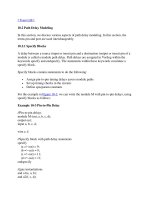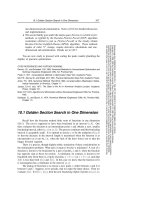Tasks And Functions part 2
Bạn đang xem bản rút gọn của tài liệu. Xem và tải ngay bản đầy đủ của tài liệu tại đây (29.62 KB, 7 trang )
[ Team LiB ]
8.3 Functions
Functions are declared with the keywords function and endfunction. Functions are used if
all of the following conditions are true for the procedure:
•
There are no delay, timing, or event control constructs in the procedure.
•
The procedure returns a single value.
•
There is at least one input argument.
•
There are no output or inout arguments.
•
There are no nonblocking assignments.
8.3.1 Function Declaration and Invocation
The syntax for functions is follows:
Example 8-6 Syntax for Functions
function_declaration ::=
function [ automatic ] [ signed ] [ range_or_type ]
function_identifier ;
function_item_declaration { function_item_declaration }
function_statement
endfunction
| function [ automatic ] [ signed ] [ range_or_type ]
function_identifier (function_port_list ) ;
block_item_declaration { block_item_declaration }
function_statement
endfunction
function_item_declaration ::=
block_item_declaration
| tf_input_declaration ;
function_port_list ::= { attribute_instance } tf_input_declaration {,
{ attribute_instance } tf_input_declaration }
range_or_type ::= range | integer | real | realtime | time
There are some peculiarities of functions. When a function is declared, a register with
name function_identifer is declared implicitly inside Verilog. The output of a function is
passed back by setting the value of the register function_identifer appropriately. The
function is invoked by specifying function name and input arguments. At the end of
function execution, the return value is placed where the function was invoked. The
optional range_or_type specifies the width of the internal register. If no range or type is
specified, the default bit width is 1. Functions are very similar to FUNCTION in
FORTRAN.
Notice that at least one input argument must be defined for a function. There are no
output arguments for functions because the implicit register function_identifer contains
the output value. Also, functions cannot invoke other tasks. They can invoke only other
functions.
8.3.2 Function Examples
We will discuss two examples. The first example models a parity calculator that returns a
1-bit value. The second example models a 32-bit left/right shift register that returns a 32-
bit shifted value.
Parity calculation
Let us discuss a function that calculates the parity of a 32-bit address and returns the
value. We assume even parity. Example 8-7
shows the definition and invocation of the
function calc_parity.
Example 8-7 Parity Calculation
//Define a module that contains the function calc_parity
module parity;
...
reg [31:0] addr;
reg parity;
//Compute new parity whenever address value changes
always @(addr)
begin
parity = calc_parity(addr); //First invocation of calc_parity
$display("Parity calculated = %b", calc_parity(addr) );
//Second invocation of calc_parity
end
...
...
//define the parity calculation function
function calc_parity;
input [31:0] address;
begin
//set the output value appropriately. Use the implicit
//internal register calc_parity.
calc_parity = ^address; //Return the xor of all address bits.
end
endfunction
...
...
endmodule
Note that in the first invocation of calc_parity, the returned value was used to set the reg
parity. In the second invocation, the value returned was directly used inside the $display
task. Thus, the returned value is placed wherever the function was invoked.
Another method of declaring arguments for functions is the ANSI C style. Example 8-8
shows the calc_parity function defined with an ANSI C style argument declaration.
Example 8-8 Function Definition using ANSI C Style Argument Declaration
//define the parity calculation function using ANSI C Style arguments
function calc_parity (input [31:0] address);
begin
//set the output value appropriately. Use the implicit
//internal register calc_parity.
calc_parity = ^address; //Return the xor of all address bits.
end
endfunction
Left/right shifter
To illustrate how a range for the output value of a function can be specified, let us
consider a function that shifts a 32-bit value to the left or right by one bit, based on a
control signal. Example 8-9
shows the implementation of the left/right shifter.
Example 8-9 Left/Right Shifter
//Define a module that contains the function shift
module shifter;
...
//Left/right shifter
`define LEFT_SHIFT 1'b0
`define RIGHT_SHIFT 1'b1
reg [31:0] addr, left_addr, right_addr;
reg control;
//Compute the right- and left-shifted values whenever
//a new address value appears
always @(addr)
begin
//call the function defined below to do left and right shift.
left_addr = shift(addr, `LEFT_SHIFT);
right_addr = shift(addr, `RIGHT_SHIFT);
end
...
...
//define shift function. The output is a 32-bit value.
function [31:0] shift;
input [31:0] address;
input control;
begin
//set the output value appropriately based on a control signal.
shift = (control == `LEFT_SHIFT) ?(address << 1) : (address >> 1);
end
endfunction
...
...
endmodule
8.3.3 Automatic (Recursive) Functions
Functions are normally used non-recursively . If a function is called concurrently from
two locations, the results are non-deterministic because both calls operate on the same
variable space.
However, the keyword automatic can be used to declare a recursive (automatic) function
where all function declarations are allocated dynamically for each recursive calls. Each
call to an automatic function operates in an independent variable space.Automatic
function items cannot be accessed by hierarchical references. Automatic functions can be
invoked through the use of their hierarchical name.
Example 8-10
shows how an automatic function is defined to compute a factorial.
Example 8-10 Recursive (Automatic) Functions
//Define a factorial with a recursive function
module top;
...
// Define the function
function automatic integer factorial;
input [31:0] oper;
integer i;
begin
if (operand >= 2)
factorial = factorial (oper -1) * oper; //recursive call
else
factorial = 1 ;
end
endfunction
// Call the function
integer result;
initial
begin
result = factorial(4); // Call the factorial of 7
$display("Factorial of 4 is %0d", result); //Displays 24
end
...
...
endmodule
8.3.4 Constant Functions
A constant function
[1]
is a regular Verilog HDL function, but with certain restrictions.
These functions can be used to reference complex values and can be used instead of
constants.
[1]
See IEEE Standard Verilog Hardware Description Language document for details on
constant function restrictions.
Example 8-11
shows how a constant function can be used to compute the width of the
address bus in a module.
Example 8-11 Constant Functions
//Define a RAM model
module ram (...);
parameter RAM_DEPTH = 256;
input [clogb2(RAM_DEPTH)-1:0] addr_bus; //width of bus computed
//by calling constant









